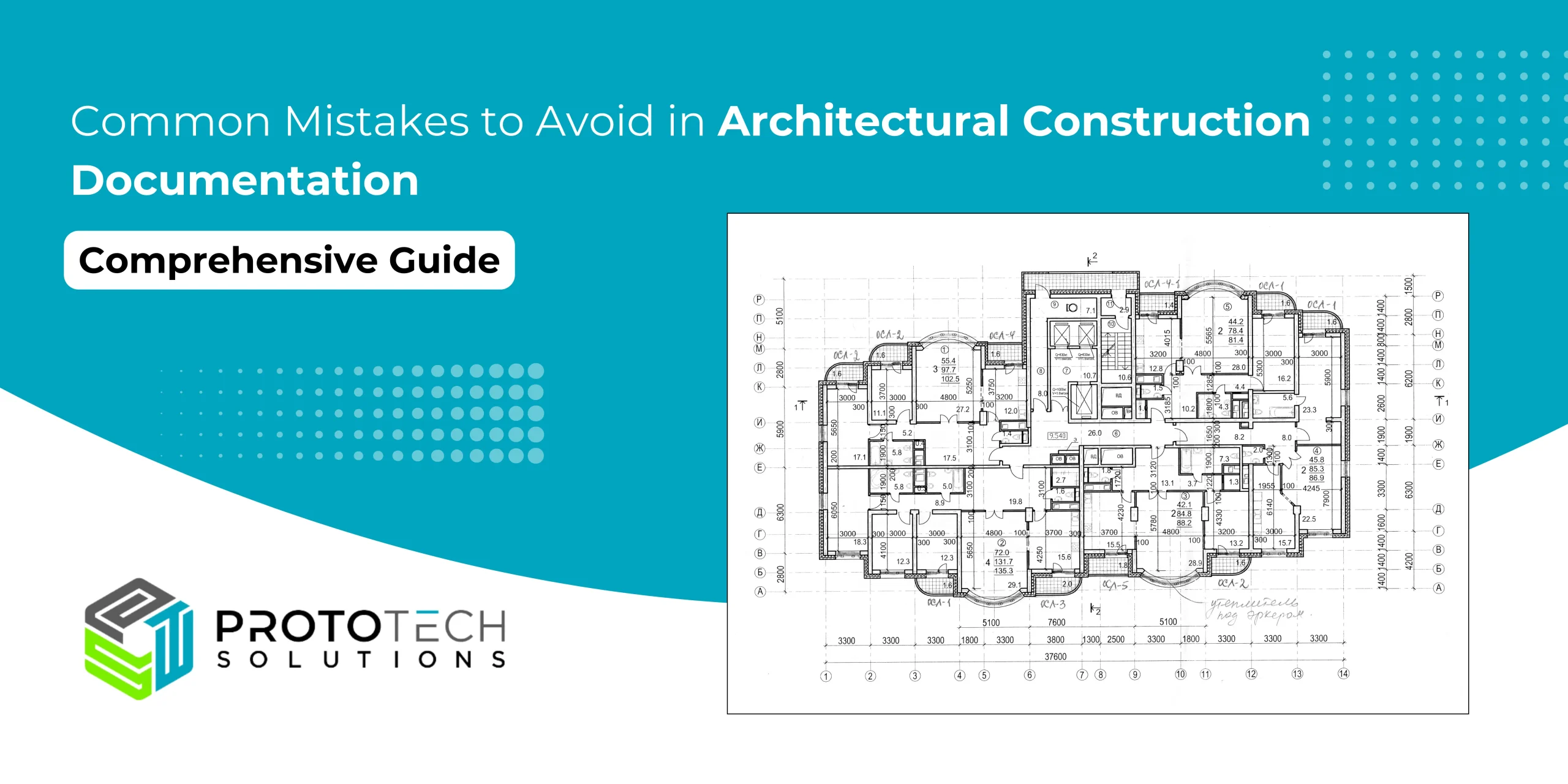Common Mistakes to Avoid in Architectural Construction Documentation
Common Mistakes to Avoid in Architectural Construction Documentation

Introduction
Architectural construction documents are comprehensive sets of drawings, plans, and specifications that outline the design and construction requirements for a building project. These documents serve as a communication tool between architects, engineers, contractors, and other stakeholders involved in the construction process. They include detailed architectural drawings such as floor plans, elevations, sections, and details, providing a visual representation of the building design.
Architectural construction documents also incorporate structural, mechanical, electrical, and plumbing drawings, coordinating various aspects of the building systems. These documents are essential for obtaining permits, bidding the project to contractors, and guiding construction activities on-site. Accuracy and clarity in architectural construction documents are crucial to preventing misunderstandings, errors, and delays during the construction process.
In the realm of architectural construction, success hinges not only on visionary designs but also on meticulous documentation. Accurate and comprehensive construction documentation serves as the backbone of any construction project, facilitating smooth execution, minimizing errors, and ensuring compliance with regulations. However, despite its critical importance, many architects and project teams often fall prey to common mistakes in this crucial aspect of their work.
In this comprehensive guide, we delve into these pitfalls and offer insights on how to avoid them for seamless project management and execution. Avoid these common mistakes in architectural construction documentation for seamless projects.
10 Common Mistakes You Must Avoid in Construction Documentation

- Incomplete Drawings and Specifications
One of the most prevalent mistakes in architectural construction documentation is the submission of incomplete drawings and specifications. Incomplete documentation can lead to misunderstandings, delays, and costly revisions during the construction phase. To mitigate this risk, architects must ensure that all drawings, plans, and specifications are meticulously detailed and accurately reflect the design intent. Regular reviews and revisions are essential to address any gaps or discrepancies in the documentation.
- Failure to Coordinate with Consultants
Architectural projects often involve collaboration with various consultants, including structural engineers, MEP (mechanical, electrical, plumbing) engineers, and landscape architects. Failure to coordinate effectively with these consultants can result in conflicting information and design discrepancies. To avoid this mistake, architects should establish clear lines of communication with consultants from the outset of the project. Regular meetings and collaborative design workshops can help ensure alignment and integration of all project components.
- Ignoring Building Codes and Regulations
Compliance with building codes and regulations is non-negotiable in architectural construction documentation. Neglecting to adhere to these standards can lead to costly fines, project delays, and even legal liabilities. Architects must stay abreast of local building codes, zoning regulations, and permit requirements throughout the design and documentation process. Consulting with regulatory authorities and engaging qualified code consultants can help ensure compliance and mitigate risks.
- Inadequate Detailing and Dimensioning
Clear and precise detailing is essential in architectural construction documentation to convey design intent accurately. Inadequate detailing and dimensioning can result in ambiguous interpretations and construction errors. Architects should provide comprehensive details for all architectural elements, including materials, finishes, connections, and interfaces. Attention to detail not only enhances constructability but also minimizes the likelihood of design conflicts and change orders during construction.
- Poor Organization and Labeling
Organization is key to effective construction documentation management. Poorly organized drawings, schedules, and specifications can lead to confusion and inefficiencies during the construction phase. Architects should establish a logical filing system and labeling conventions for all project documents. Clear indexing, numbering, and revision tracking facilitate easy retrieval and reference, ensuring that stakeholders can access the information they need promptly.
- Lack of Clarity in Communication
Effective communication is essential for successful project delivery, and architectural construction documentation serves as a primary means of communication among project stakeholders. Ambiguous or unclear language, symbols, and notation can lead to misinterpretations and errors. Architects should strive for clarity and consistency in their documentation, using standardized terminology and graphical conventions. Regular communication channels should be established to address queries and provide clarification promptly.
- Overlooking Constructability Issues
Architectural designs that appear flawless on paper may encounter significant challenges during the construction phase if constructability issues are overlooked. Failure to consider factors such as site constraints, material availability, and construction sequencing can result in costly revisions and delays. Architects should collaborate closely with contractors and construction professionals to assess constructability early in the design process. Value engineering exercises and constructability reviews can help identify and address potential challenges before they escalate.
- Relying Solely on Digital Documentation
While digital documentation offers many benefits, including ease of sharing and collaboration, relying solely on digital formats can pose risks, particularly in the event of technology failures or data loss. Architects should maintain backups of all project documentation in multiple formats, including hard copies and cloud-based storage solutions. Hybrid approaches that combine digital and physical documentation provide redundancy and ensure continuity, especially in high-stakes scenarios.
- Neglecting Quality Control and Assurance
Quality control is paramount in architectural construction documentation to maintain accuracy and consistency throughout the project lifecycle. Neglecting quality control processes can result in errors, omissions, and rework, undermining project efficiency and credibility. Architects should implement robust quality assurance procedures, including peer reviews, document audits, and verification checks. Investing time and resources in quality control upfront can yield substantial savings by preventing costly mistakes downstream.
- Failing to Update Documentation
Architectural projects are dynamic endeavors that evolve, necessitating frequent updates to construction documentation. Failing to update documentation promptly can lead to discrepancies between the design intent and the actual construction progress. Architects should establish protocols for managing document revisions and revisions, ensuring that all stakeholders have access to the latest information. Regular site visits and inspections can help verify as-built conditions and inform documentation updates as needed.
Option for Outsourced Construction Documentation Services to Prevent Errors in Project
Looking for ways to improve the efficiency and accuracy of your construction projects? Consider the option of outsourcing construction documentation services for your project. Look no further! Think of ProtoTech Solutions, our expertise, ensures meticulous attention to detail, preventing errors that could lead to costly delays or rework. Our team is equipped with the latest tools and techniques, delivering high-quality documentation tailored to your specific requirements. Our services include architectural construction documentation, structural construction documentation, and MEP construction documentation. Trust ProtoTech Solutions to streamline your construction process and mitigate risks associated with documentation errors. Get in touch with us today to learn more about how we can support your ongoing and upcoming construction projects.
Conclusion
Avoiding common mistakes in architectural construction documentation is critical for the success of any construction project. By prioritizing accuracy, clarity, and collaboration throughout the documentation process, architects can minimize risks, enhance project efficiency, and deliver exceptional results that exceed client expectations. Vigilance, attention to detail, and a commitment to continuous improvement are essential for navigating the complexities of modern architectural practice and achieving excellence in construction documentation.

